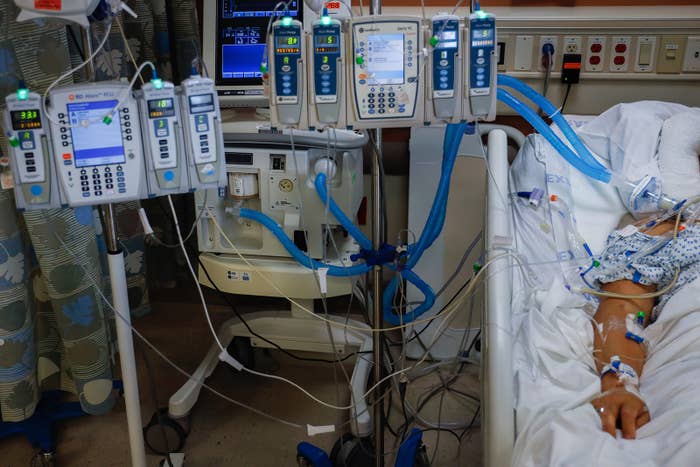
BuzzFeed News has reporters across five continents bringing you trustworthy stories about the impact of the coronavirus. To help keep this news free, become a member and sign up for our newsletter, Outbreak Today.
The novel coronavirus pandemic is upending health care as a business, a profession, and a human relationship. As an infectious disease physician on the frontlines, I am bearing witness daily to hardships and tragedies befalling my patients, their families, health care providers, my work colleagues, and society as a whole.
Ironically, it is some of my non-COVID-19 patients who are teaching me to maintain resilience and hope in the face of compounding adversity. With his permission, I would like to tell you about one of them.
Mr. S had an extraordinary series of setbacks. He and his entire family contracted influenza at the end of January. Strike one. Soon after, he developed a severe strep throat. Strike two. Then, the strep bacteria causing his sore throat ended up invading his bloodstream and circulated throughout his body. A devastating strike three.
Strikes 4–16 (and still rising) were a cascade of complications resulting from system-wide toxin production from the circulating strep. They included:
- Septic shock requiring ICU admission, 24-hour nursing and physician care, and lifesaving blood pressure support
- Respiratory failure requiring intubation, ventilation, and ultimately a breathing tube surgically placed into his neck
- Kidney failure requiring dialysis
- Sloughing off of large patches of skin, creating large open wounds
- Gangrene of all fingers and toes which will ultimately need amputation
- Multiple strokes
- Additional lung infections involving aggressive bacteria and more recently, mold
I began caring for Mr. S. in January, before our state confirmed any cases of the novel coronavirus, and when there were only a few cases reported nationally. I knew that in situations like his, mortality rates exceed 80%. I knew that if he survived, he would remain in the hospital for months and that his life would never be the same. As the onslaught of COVID-19 unfolded in our world and in our region, he remained my unresponsive, paralyzed, intubated patient — a husband, a father, a professional, silently struggling for his life.
His ICU bay was decorated with photos of his family, his dog, drawings from his children. His relatives would visit, hold his limp bandaged hands, cry, and pray. In early March, our hospital began restricting all visits from friends and family to minimize exposure to the novel coronavirus. Overnight, Mr. S. instantly went from being in the shadows to being alone.
Mr. S remained largely in solitude as the COVID-19 pandemic worsened. His family and friends, unable to be with him physically, would join him over FaceTime for a few brief moments each day, cheering on their husband and dad, their silent hero.
Last week I stopped by to evaluate Mr. S in the ICU, joined via teleconference by a group of enthusiastic students who were shadowing me during “Virtual Rounds.” As I walked in, I was shocked. Mr. S was awake and alert. He made eye contact with me, and smiled.
I approached him and grasped his hand in disbelief. “Mr. S?”
“Yes,” he silently mouthed, his voice absent as a result of his tracheostomy.
“Do you know who I am?”
“No,” he replied, still smiling.
“I’ve helped take care of you for the past two months. This is the first time you and I have actually spoken.”
“Thank you,” he mouthed, smiling and nodding.
It is hard to encapsulate in words what went through me in that moment. Here was a person who had defied the odds of survival and endured unspeakable challenges. I am certain he understood that his life, his body, his existence would never be the same. He had spent the last three months sedated, without sentience or full awareness, as a monumental global emergency unfolded. As many of his ICU neighbors, COVID-19 and non-COVID-19, came and went, he remained.
When he finally awoke, he was connected to machines, likely confused, scared, unable to speak, and without family present or able to visit. I could not imagine a more poignant definition of alone.
Yet Mr. S was bright-eyed, talkative despite lacking a voice, and in good spirits. He said hello to my team of students over video, and he turned his bandaged hands so they could see their first example of extensive gangrene. He understood that he had straddled the fine line between life and death, and that his case would be momentous in the education and career decisions of these future clinicians. As my students began to thank him, he interrupted them and thanked them instead.
Intensive care for a single critically ill patient requires a Herculean 24/7 effort by nurses, intensivists, respiratory therapists, phlebotomists, pharmacists, anesthesiologists, specialists, residents, fellows, staff, and facility workers. While the COVID-19 pandemic has brought this effort and the patient experience to the forefront, and rightfully so, we would be remiss as a society to forget the other critically ill patients who remain vulnerable, struggling in silence. They are more alone now than ever before.
While I continue to see critically-ill patients, I always stop by and see Mr. S. At this point, he does more for my spirit than I do for him.
Dr. Sudeb Dalai is an infectious disease physician, Stanford professor, medical director at Karius, and the creator of IDMonitor.org. He provides care for both COVID-19 and non-COVID-19 critically ill patients and a wide variety of other complicated illnesses.
